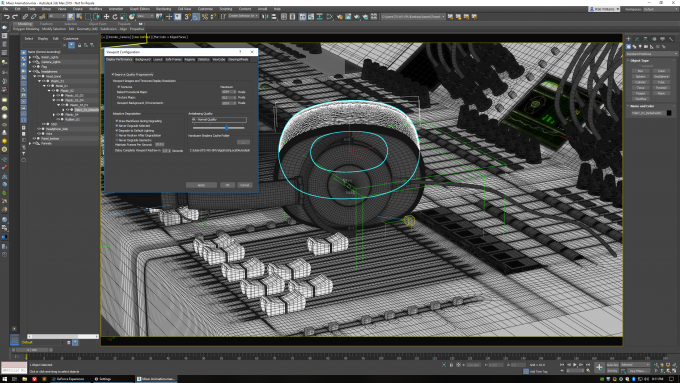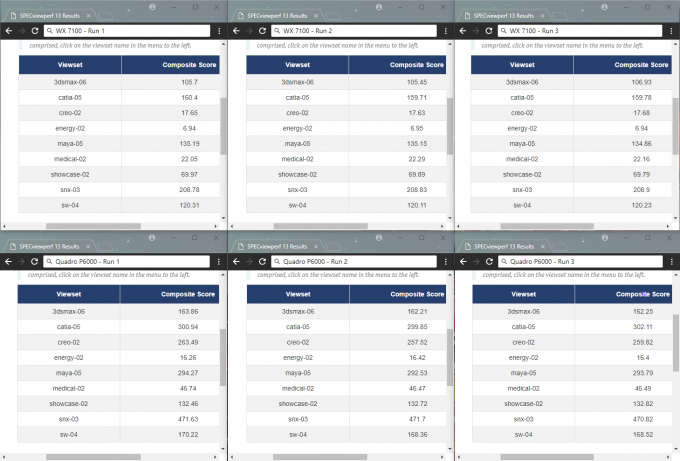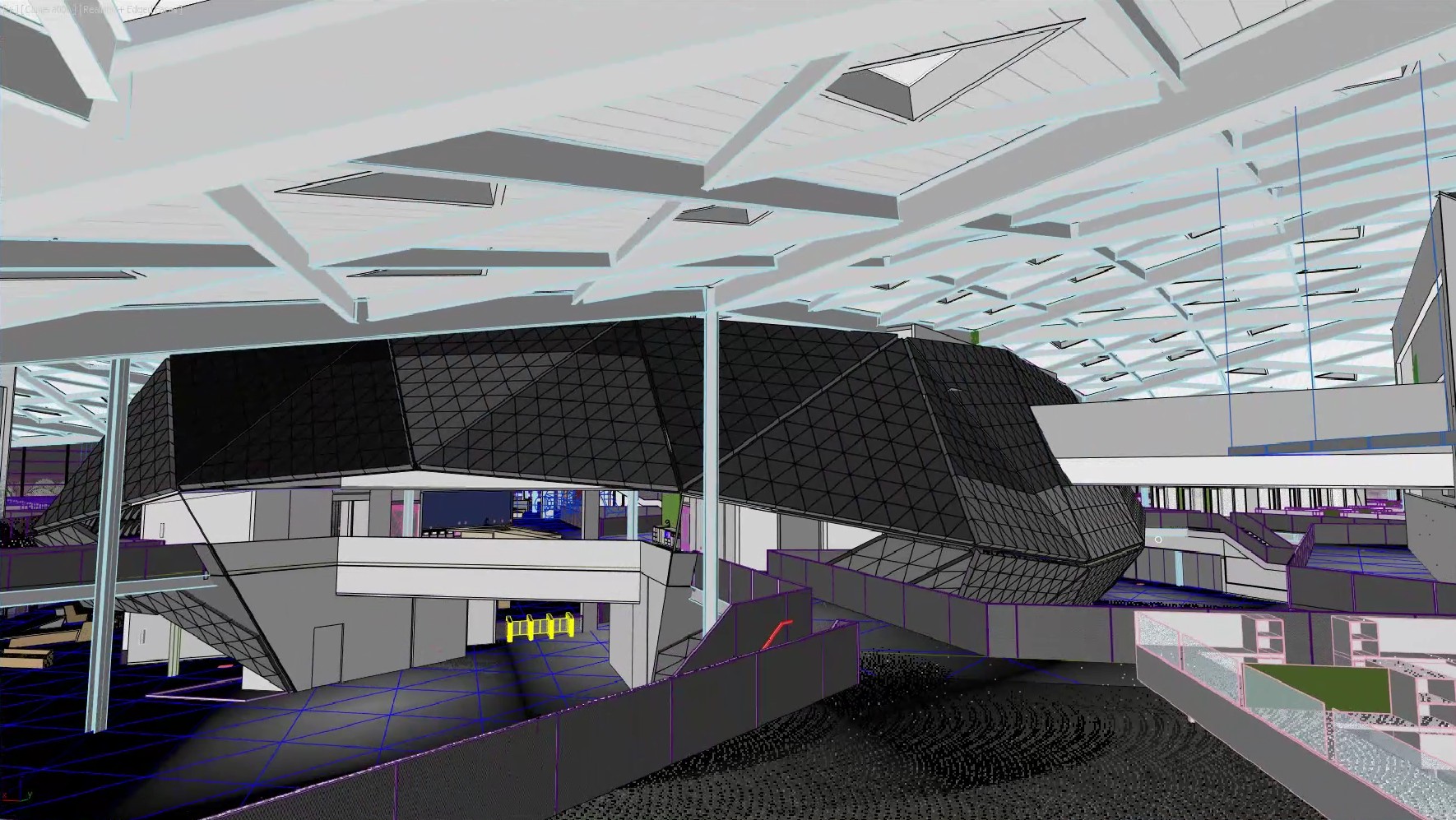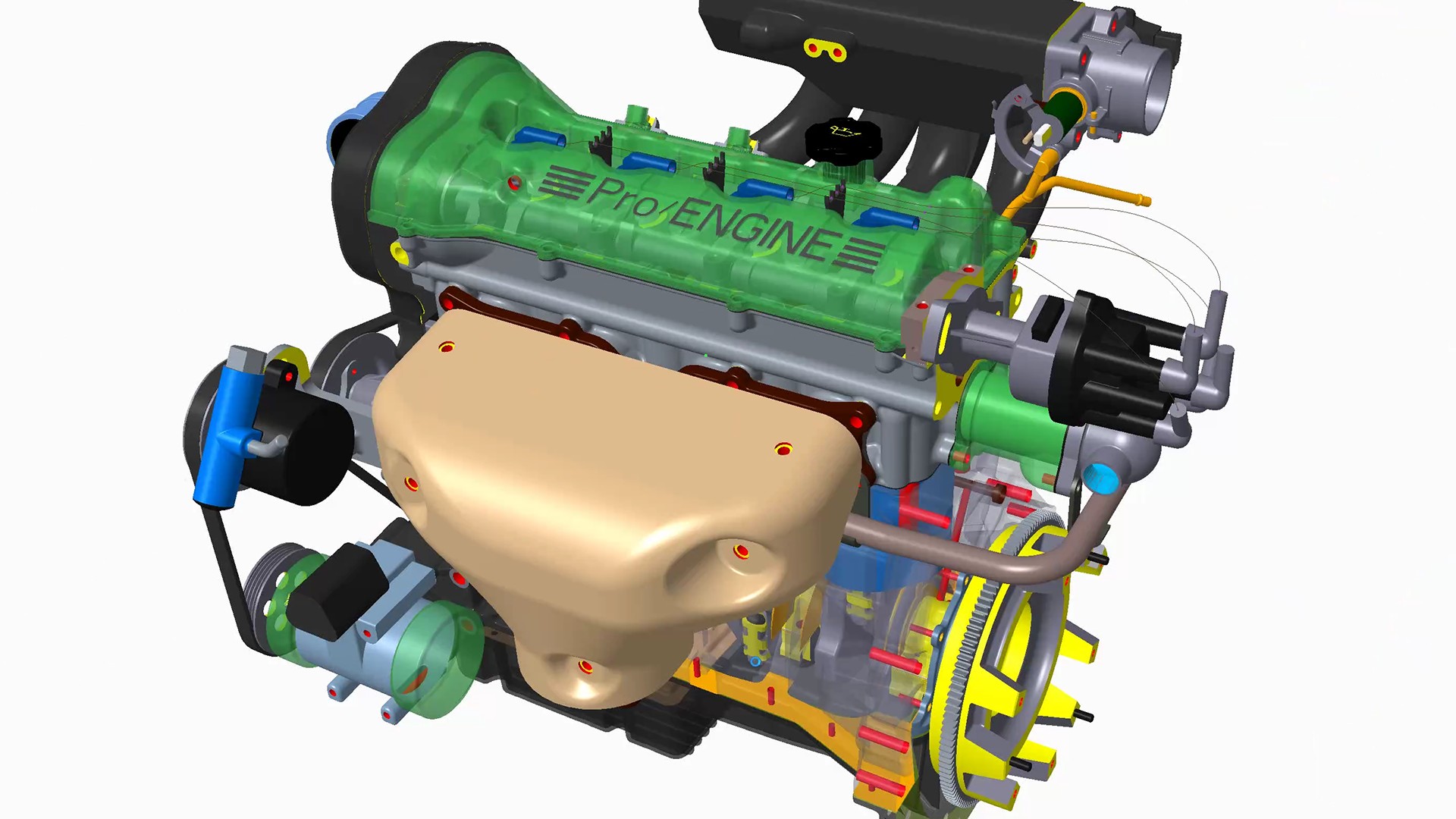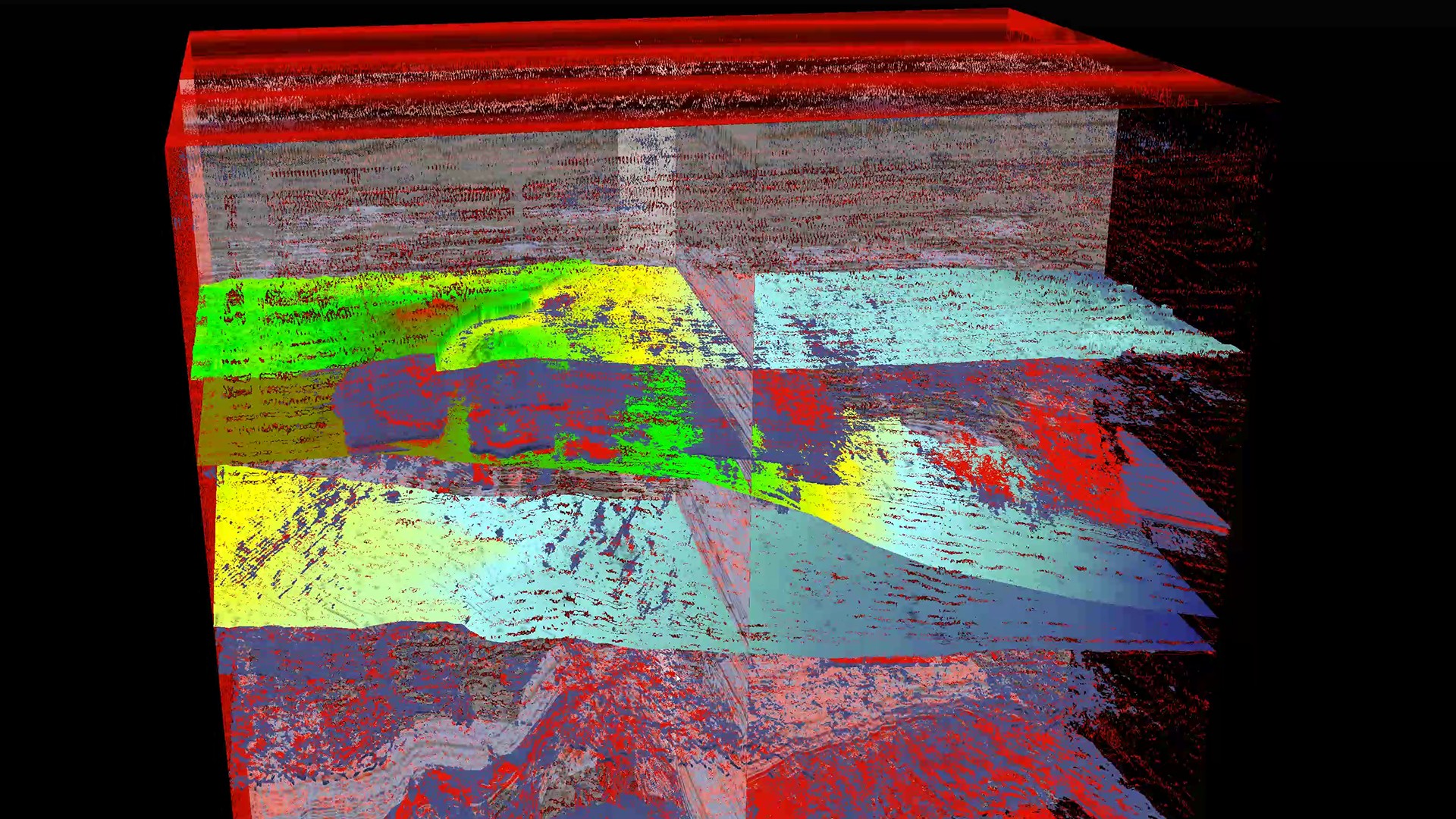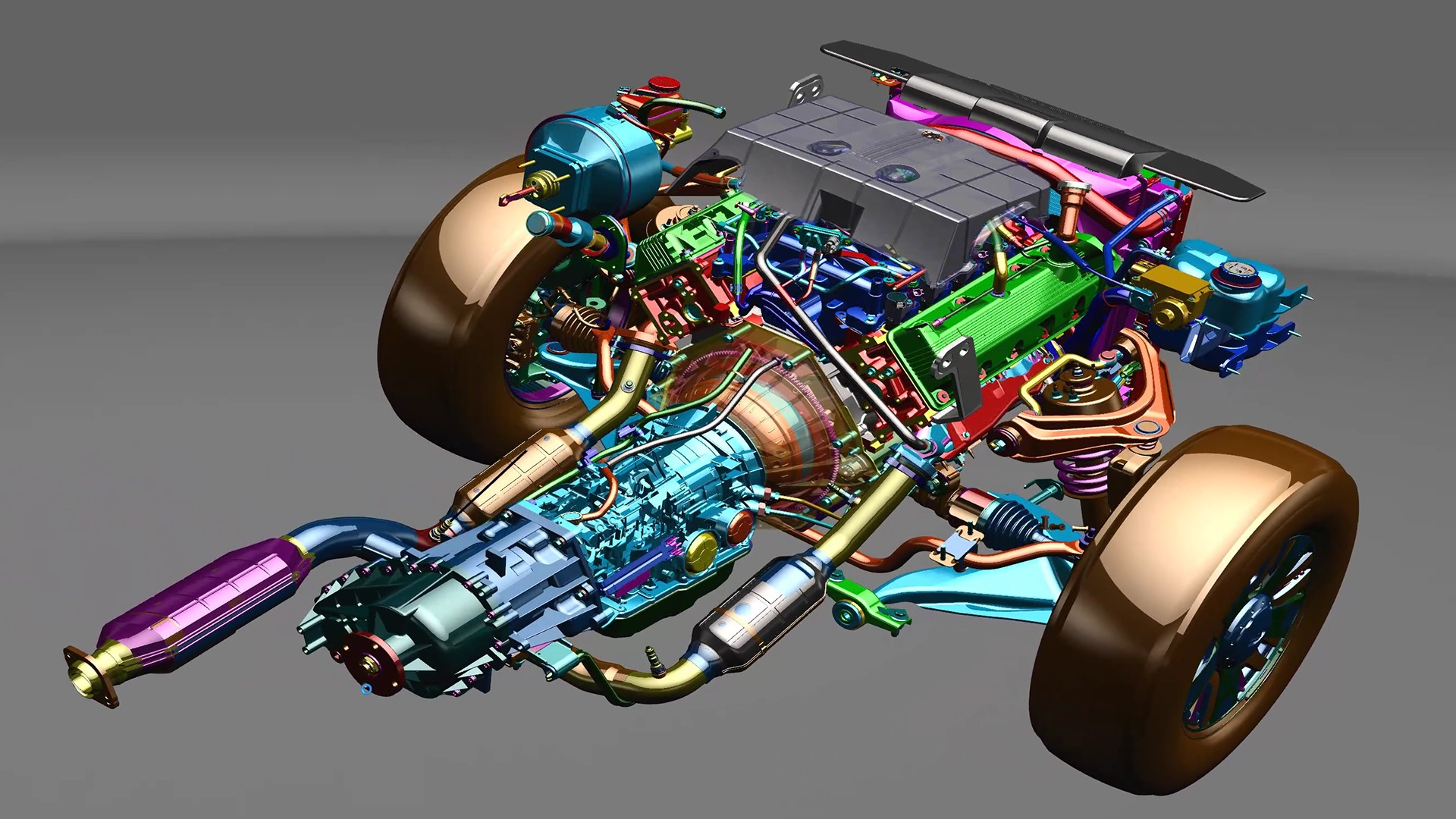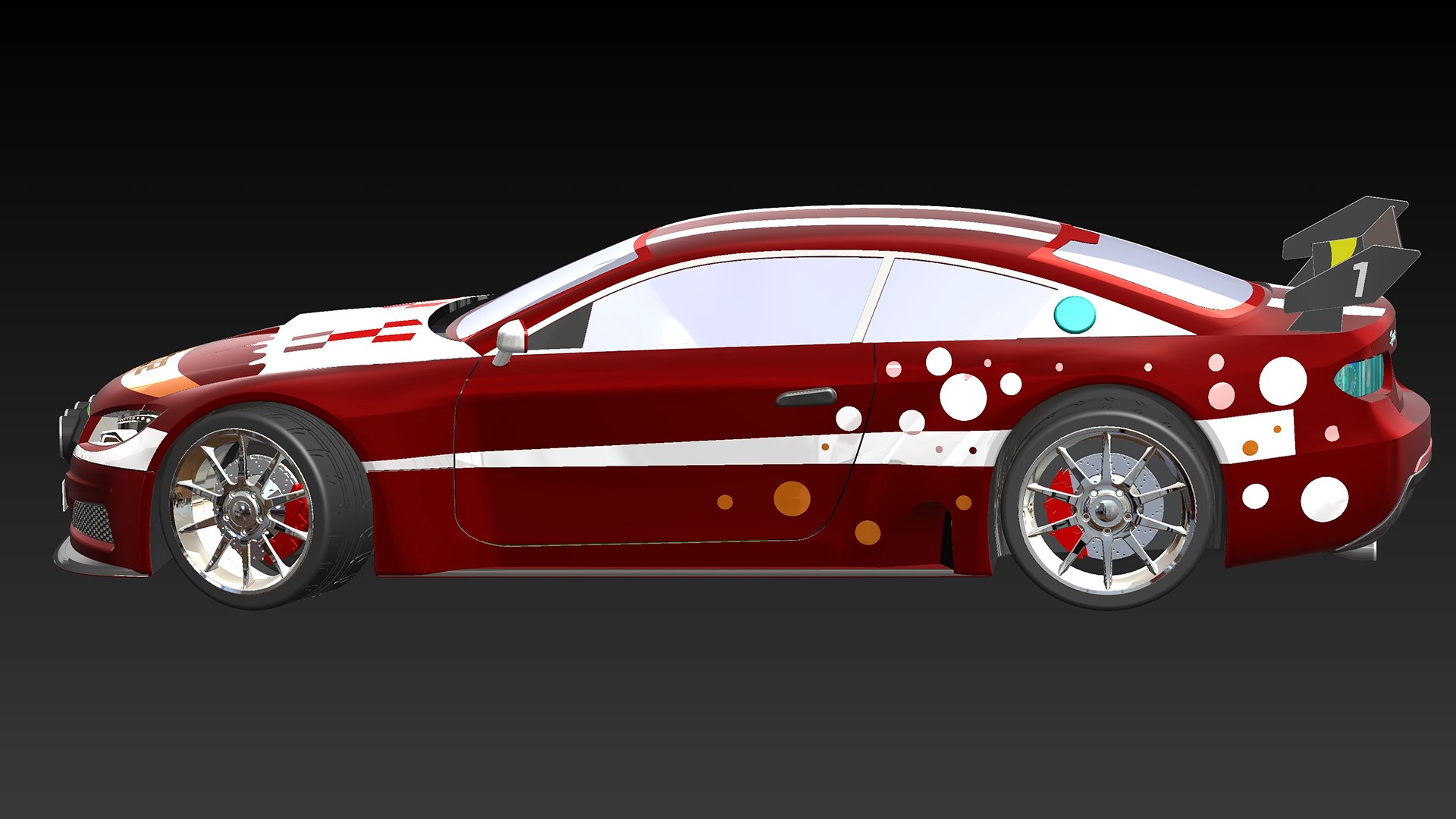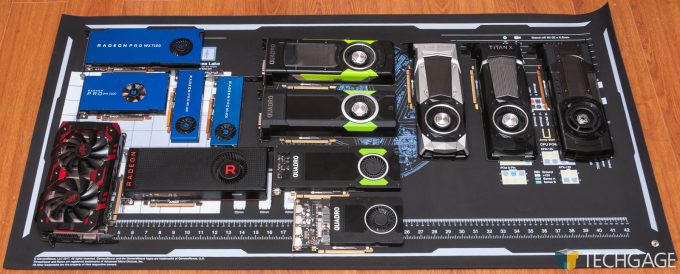- Qualcomm Launches Snapdragon 4 Gen 2 Mobile Platform
- AMD Launches Ryzen PRO 7000 Series Mobile & Desktop Platform
- Intel Launches Sleek Single-Slot Arc Pro A60 Workstation Graphics Card
- NVIDIA Announces Latest Ada Lovelace Additions: GeForce RTX 4060 Ti & RTX 4060
- Maxon Redshift With AMD Radeon GPU Rendering Support Now Available
SPECviewperf 13: A Look At Viewport Performance In SolidWorks, CATIA & More

Continuing our workstation performance analysis, we’re tossing our usual fleet of GPUs against eight separate tests, all made possible through SPECgpc’s SPECviewperf 13. With this testing, we can show current state of viewport performance in SolidWorks, CATIA, Maya, 3ds Max, Creo, and Siemens NX – as well as visualization tools for medical and energy.
Autodesk AutoCAD viewport performance can be found right here.
Over the past couple of months, we’ve analyzed workstation performance from a number of different angles. In April, we took a look at both Chaos Group’s V-Ray, and AMD’s Radeon ProRender, and soon after, a full onslaught of tests hit the same twelve GPUs for a good look at performance across a wide-range of workloads.
Following that article, reader test requests led to another article this past weekend, diving into a look at performance with Redshift’s biased GPU renderer, MAGIX’s popular Vegas video editor, and one of the best open-source tools going: Blender.
In this article, our workstation performance analysis continues with a look at viewport performance across eight pieces of software that heavily rely upon GPU acceleration. What’s a viewport? In a 3D-rendered nutshell, it’s the big window where all of the scene manipulation happens. The better-suited the graphics solution, the better the acceleration of this continually rendered window.
Viewport Performance Matters!
With viewport performance, it’s dangerous to assume that the graphics card you have your eye set on will work ideally with your workload if you haven’t done any research. With gaming, it’s generally safe to assume that a graphics card at a certain performance level is going to deliver similar results across a big selection of titles, but when do you remember a high-end gaming GPU being great in only half of the games out there?
The ProViz market is a lot different. AMD and NVIDIA both put lots of R&D dollars into their driver optimization. Both companies regularly work with the likes of Dassault, Autodesk, Siemens, et cetera, to ultimately make sure nothing holds performance back on their respective graphics solutions.
If you need proof that viewport performance matters, look no further than the fact that the folks at SPECgpc have created an entire benchmark suite with viewport performance as the sole performance measure. Production rendering is important, sure, but you can at least walk away from a PC while rendering is taking place. There’s no alternative like that when you’re forced to interact with a slow viewport.
It’s SPEC’s work that has made an article like this possible. With its recently launched SPECviewperf 13, viewport performance from 3ds Max, Maya, Siemens NX, Creo, CATIA, and SolidWorks can be measured, as well as visualization tools for energy and medical scenarios. With both AMD and NVIDIA part of SPECgpc, you as a consumer should trust SPECviewperf’s reliability, and accuracy.
On the topic of accuracy, it’s one of the reasons I like SPEC so much – it sees things the same way we at Techgage do when it comes to wanting to deliver results people can trust. The company employs tracing techniques in each viewset to make sure the end results are as accurate on one vendor as they are another. The below is a screenshot of three runs each for both the WX 7100 and P6000, as an example of consistency:
Across every single GPU I tested, the results kept consistent enough to tell me that one run is enough, but two can’t hurt. Three is simply a waste of time, so I’ll stop being a dummy by sticking to two runs in the future. In reality, the second run is only for sanity’s sake. You never know when Windows will throw a wrench in a test run, invisible to the eye.
Testing Viewport Performance With SPECgpc’s SPECviewperf 13
But enough about all that; it’s time to tackle performance (aka: the entire point of this article). The exact same collection of GPUs that was used for the past couple of benchmarking articles has been used again here, with drivers that are still completely up-to-date as of the time of writing.
| Techgage Workstation Test System | |
| Processor | Intel Core i9-7980XE (18-core; 2.6GHz) |
| Motherboard | ASUS ROG STRIX X299-E GAMING (1401 EFI) |
| Memory | HyperX FURY (4x16GB; DDR4-2666 16-18-18) |
| Graphics | AMD Radeon RX Vega 64 8GB (Radeon 18.6.1) AMD Radeon RX 580 8GB (Radeon 18.6.1) AMD Radeon Pro WX 7100 8GB (Radeon Pro 18.Q2.1) AMD Radeon Pro WX 5100 8GB (Radeon Pro 18.Q2.1) AMD Radeon Pro WX 4100 4GB (Radeon Pro 18.Q2.1) AMD Radeon Pro WX 3100 4GB (Radeon Pro 18.Q2.1) NVIDIA TITAN Xp 12GB (GeForce 398.11) NVIDIA GeForce GTX 1080 Ti 11GB (GeForce 398.11) NVIDIA Quadro P6000 24GB (Quadro 397.93) NVIDIA Quadro P5000 16GB (Quadro 397.93) NVIDIA Quadro P4000 8GB (Quadro 397.93) NVIDIA Quadro P2000 4GB (Quadro 397.93) |
| Audio | Onboard |
| Storage | Kingston KC1000 960GB M.2 SSD |
| Power Supply | Corsair 80 Plus Gold AX1200 |
| Chassis | Corsair Carbide 600C Inverted Full-Tower |
| Cooling | NZXT Kraken X62 AIO Liquid Cooler |
| Et cetera | Windows 10 Pro build 17134 |
| For an in-depth pictorial look at this build, head here. | |
The scores in the graphs below represent the average after three runs. As mentioned above, two runs is sufficient, but since I wasted time on running the tests three times this go-around, it just makes for even more refined numbers. A major new feature of SPECviewperf 13 is the ability to run the tests at 4K resolution, so to cover even more ground, both that and 1080p results are included.
It’s important to note that these are “scores” and not FPS results. They’re the end result of SPECviewperf’s algorithm poring over the performance of individual test results, which of course are weighted differently. Ultimately, the better the score, the better the overall performance.
Dassault Systèmes SolidWorks
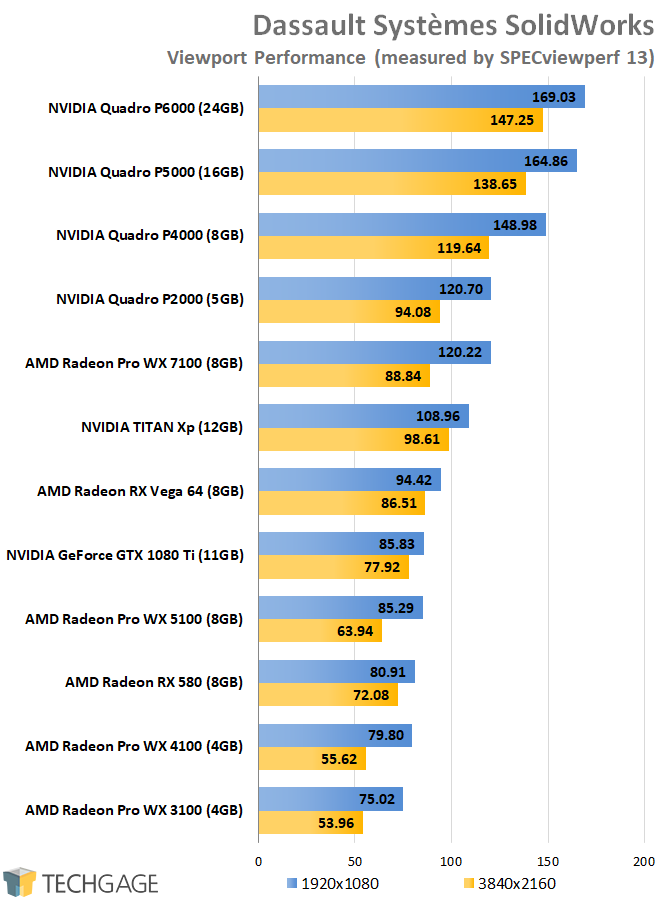
Certification isn’t the only thing you gain in SolidWorks if you go the pro GPU route – performance will see a major boost, as well. Last fall, NVIDIA released a workstation performance-boosting driver for the TITAN series, and while it made a huge difference, the TITAN Xp sits in the dust of the Quadro P6000.
AMD’s Radeon Pro WX 7100 performs extremely well here, managing to place ahead of every NVIDIA gaming card, but over on the green side, serious optimization work allows a lower-end card like the Quadro P2000 to outperform both the high-end RX Vega 64 and GTX 1080 Ti.
Dassault Systèmes CATIA
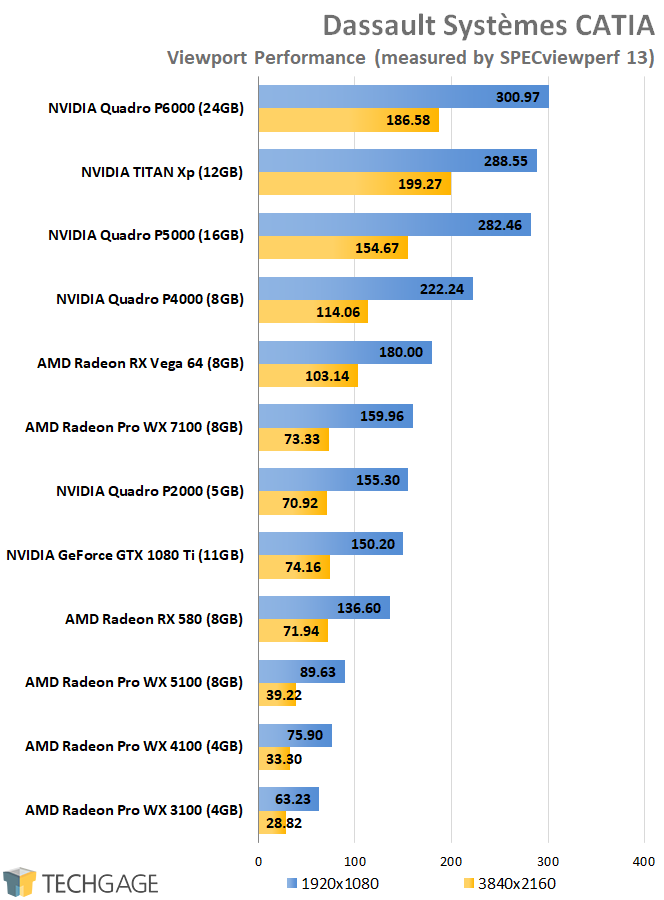
While the TITAN Xp saw no real advantage in SolidWorks over a typical GeForce, CATIA shakes things up quite a bit, giving us our first real taste of the importance of understanding your benchmark. Here, the TITAN Xp doesn’t just outperform the GTX 1080 Ti, it sits behind only the Quadro P6000.
AMD also has some obvious optimizations in place for its Radeon Pro line, but the difference is not as stark as it is between GeForce and Quadro. That means that the faster the Radeon, the better. We can see that with the RX Vega 64 outperforming every other Radeon – even the product-certified WX 7100.
Siemens NX
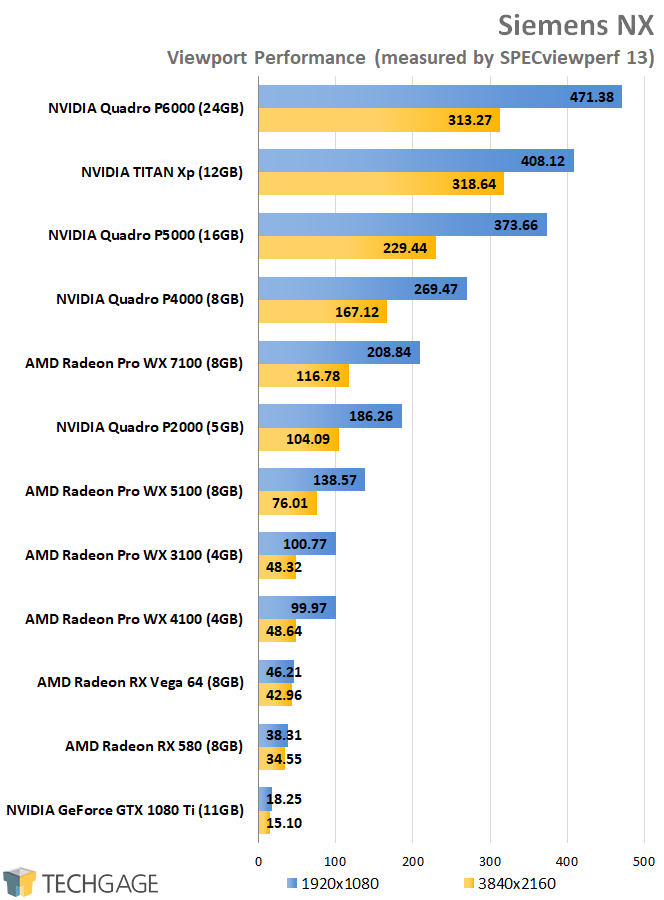
A friend of mine once purchased a workstation graphics card based on its price alone, assuming that a $2,000 USD option had to be better than a $600 one. Luckily for him, the workstation card offered enough performance to get him by, so no true harm was done.
Imagine that same scenario, but in the inverse: someone purchases a gaming GPU instead of a professional one for Siemens NX. They then instead get 18 FPS at 1080p instead of 186 FPS from a lower-priced alternative. This is true for both AMD and NVIDIA cards, with the WX 7100 performing much better than the RX Vega 64.
PTC Creo
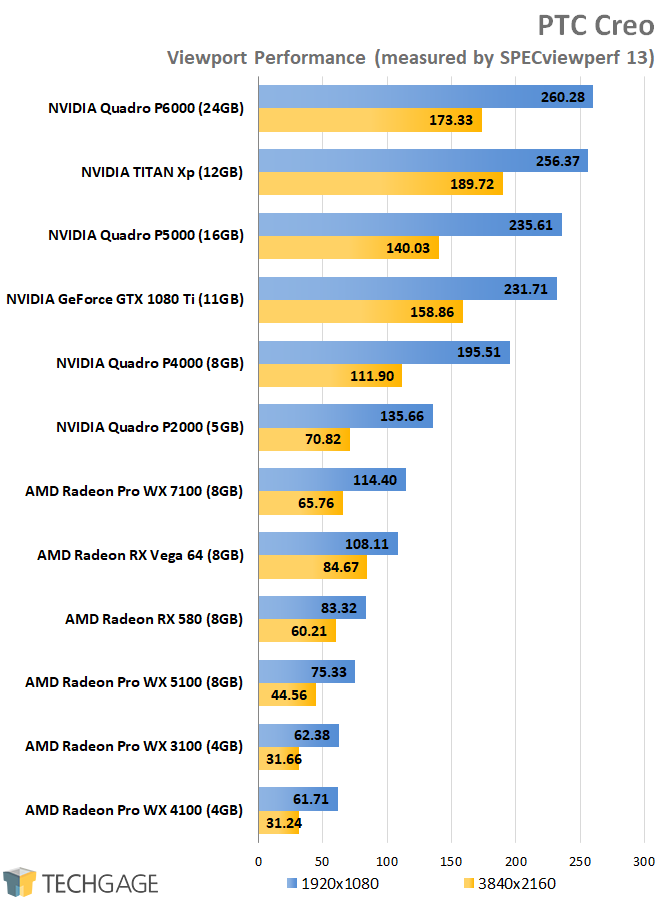
No performance article involving a complex set of results would be complete without a few head-scratchers. In this Creo test, AMD’s Polaris-based graphics cards face a harsh existence at the bottom of the chart, something that was not seen in our previous SPECviewperf 12 testing. With 13, the Vega card scales fairly similarly to how it did in 12, but AMD’s WX cards should be showing an advantage over the gaming equivalents. I am still waiting for word from AMD to explain this anomaly.
When this article was first published, performance from both the WX and RX Radeon cards built on the Polaris architecture suffered severe performance degradation in PTC Creo, to a logic-defying degree. Ultimately, it seems like a bug crept into the driver at some point, and fixing the issue is as difficult as installing a different driver.
AMD currently recommends the Radeon Pro Adrenaline 18.5.1 driver for use with the WX cards, and based on additional testing, we can recommend the new Adrenalin 18.7.1 driver for the RX cards, which fixed the performance of the RX 580 from our original testing. While we don’t have one here to test, we’d assume that WX 9100 owners are safe to continue using the latest 18.Q2 driver, since the Vega-based RX Vega 64 fared just fine before. And on that note, the Vega 64 was also retested using the 18.7.1 driver, and gained a point at both resolutions.
That said, it’s clear that NVIDIA rules the Creo roost, as even the lowbie Quadro P2000 beats out everything here. As the WX 7100 performs better than the RX 580 by a very notable margin, I’d hazard a guess that the WX 9100 would slide in between the P2000 and P4000 – but since those cards cost much less, dedicated Creo users don’t have a difficult choice to make here.
Autodesk 3ds Max & Maya
More in-depth 3ds Max and Maya results can be found right here.
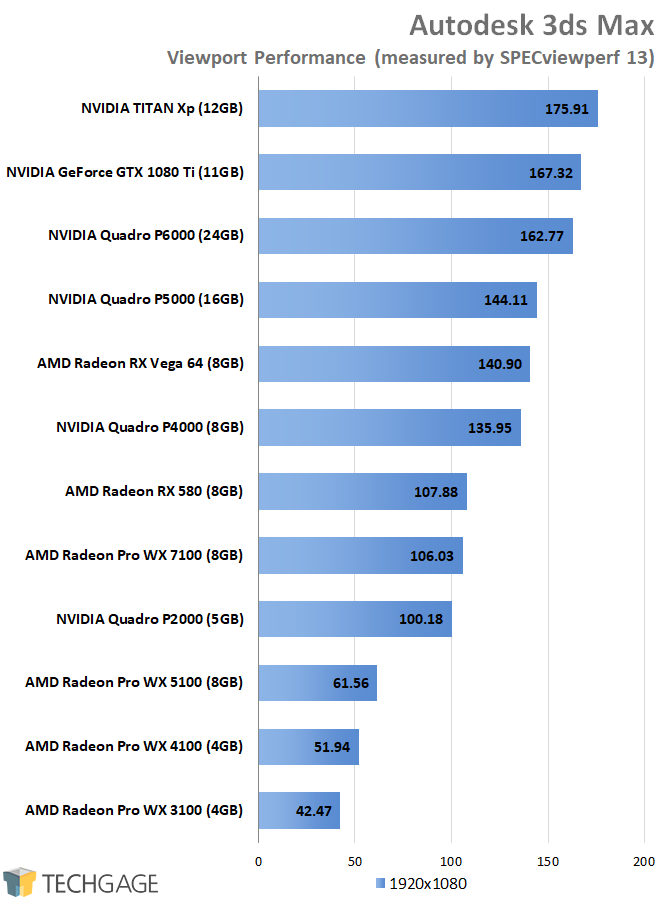
3ds Max is the only test (I use) in SPECviewperf 13 that doesn’t have a 4K option, hence the complete lack of orange in the graph above. With these results, we can see that driver optimizations seem to help some NVIDIA GPUs, such as the P2000, which fares well against the WX 7100. Meanwhile, the Vega 64 performs almost identically to the P5000, which makes sense, since their rated performance is similar.
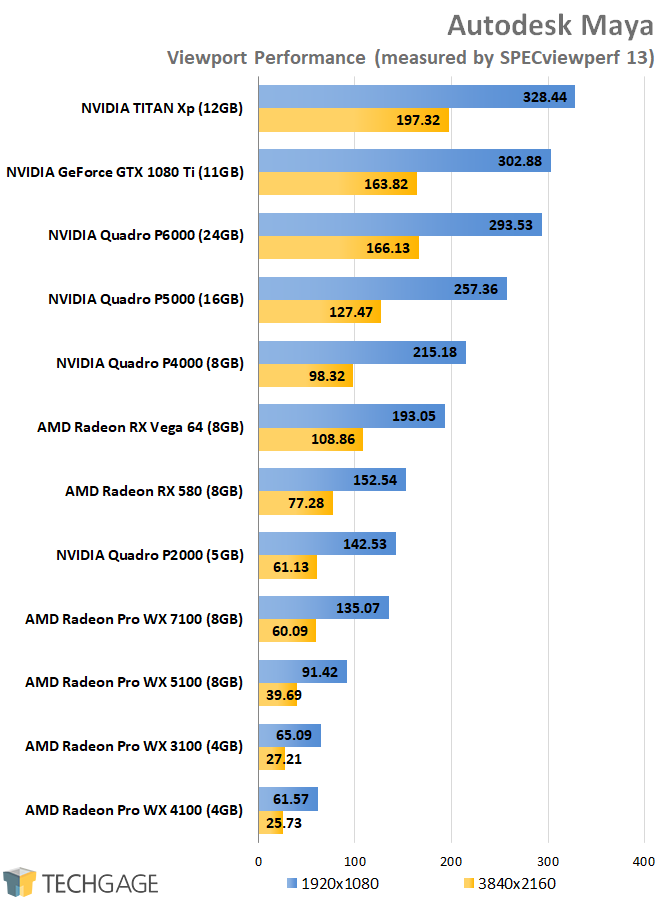
With Maya, we can see the same kind of scaling as with 3ds Max. Ultimately, NVIDIA’s cards offer the best performance; it’s just not much of a competition. That’s two Autodesk applications that perform better on NVIDIA, but AutoCAD, which we also have performance for, makes a third. Hopefully we can see performance continue to improve with these tools on the AMD side as more driver releases hit us.
Medical & Energy Viewports
Now for something a little different. The final two tests represent visualization software researchers, doctors, and et cetera, use to interpret the mass amounts of data gathered via myriad techniques. The amount of data being churned through to generate accurate visualization on the screen is rather immense – especially since it doesn’t give that impression just by looking at it.
In the medical tests, 3D volumetric models are generated from 2D projections, with the datasets including multiple MRI and CT scans. Generated in a similar manner, the energy test represents the visualization of seismic data.
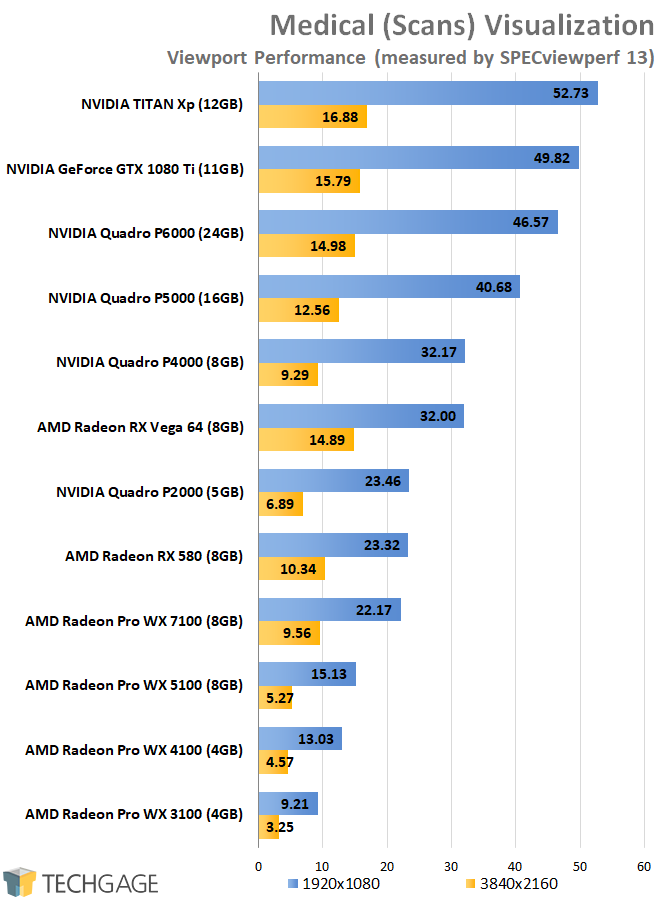
The medical test follows the 3ds Max and Maya ones nicely by scaling almost identically. NVIDIA’s on top, and once again sees its lower Quadros outperforming the entire AMD stack (that we have on hand). The Quadro P4000 and Vega 64 perform similarly, with the Polaris-based Radeons falling behind most of NVIDIA.
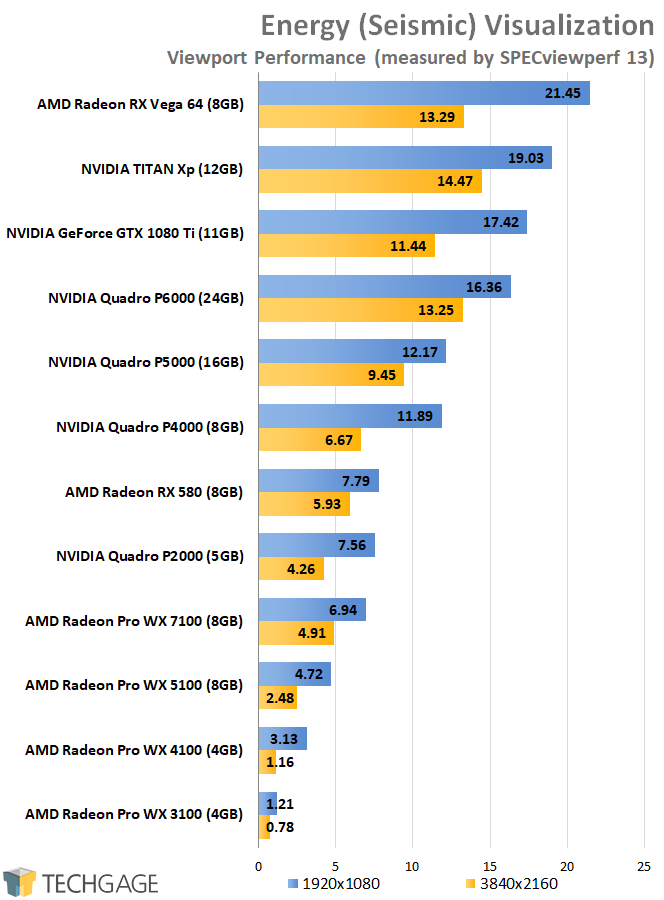
Thankfully, the energy results give us something interesting to discuss before wrapping-up: AMD’s RX Vega 64 dominates. The TITAN Xp’s 12GB memory seems to gain it an advantage at 4K, but overall, the Vega 64 performs exceptionally well in comparison.
Final Thoughts
This article might have largely revolved around a singular suite, but to call SPECviewperf 13 a single benchmark would be inaccurate. It’s more of a framework for individual benchmarks. A tool like UL’s 3DMark might cater to the vast majority of PC gamers out there, but that kind of simplicity is non-existent on the ProViz side. We couldn’t run a single test from SPECviewperf’s collection and consider it to be “good enough”, whereas not every 3DMark test needs to be run to deliver a good picture of performance.
That all being said, it wouldn’t be fair to end an article like this by saying that one vendor is better than another, because that’s entirely dependent on workload. Ultimately, NVIDIA gets the nod more often than not, a reality AMD is not ignorant of. But at the same time, AMD slays in certain tests, such as the final one in this performance look, for energy.
I already hate myself for saying this so much, but it truly does pay to know your workload. In some cases, a gaming card will cripple your performance, while at the same time, going with an opposing vendor could cripple it just the same. This is one of the reasons I find the workstation market so fascinating, but I will say one thing: I’m thankful the gaming performance side of things is not quite as sporadic!
Support our efforts! With ad revenue at an all-time low for written websites, we're relying more than ever on reader support to help us continue putting so much effort into this type of content. You can support us by becoming a Patron, or by using our Amazon shopping affiliate links listed through our articles. Thanks for your support!




